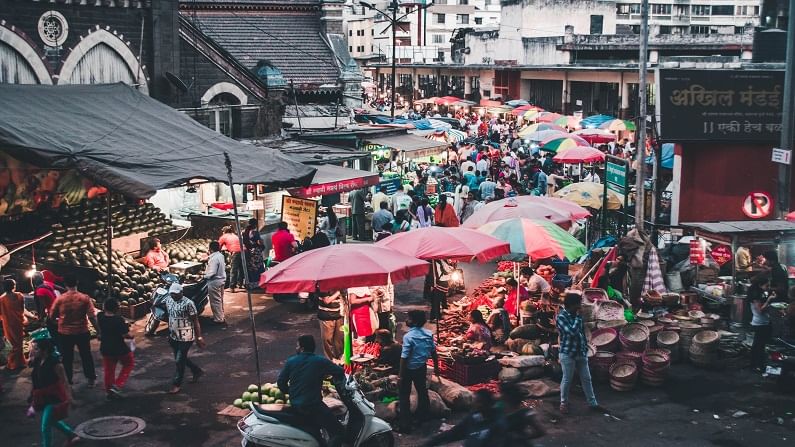FY21 GDP estimates at -8% may see upward revision: SBI
One likely consequence of any upward revision in FY21 estimates is a concomitant decline in FY22 GDP estimates

It is likely that the previously published CSO GDP growth for FY21 at –8% might see an upward revision once the numbers are released on 31 May’21, the country’s largest public sector lender said in a research report released Tuesday. “Based on quarterly GDP numbers in FY21 and full year FY21 GDP estimates, Q4GDP was projected to reveal a contraction of 1.1% . Based on SBI Nowcasting model the forecasted GDP growth for Q4 would be around 1.3% (with downward bias). We now expect GDP decline for the full year to be around -7.3% (our earlier prediction: -7.4%),” the State Bank of India said.
Rising infections in rural districts One likely consequence of any upward revision in FY21 estimates is a concomitant decline in FY22 GDP estimates. Even as we ponder over FY22 GDP estimates, COVID-19 infection is still spreading in rural areas.
“The share of rural districts in new cases is rising quite rapidly during May, even though overall cases have started to decline from the second week of May. It has increased from 45.5% in end-Apr’21 to 53.6% as per the latest data. Notably, this is same as the peak of 53.7% observed during end-Aug’20. Top 20 rural districts now account for around 15% of country-wise new cases with hinterlands of Andhra Pradesh, Maharashtra and Karnataka continuing to be the worst affected as per the reported data,” the report said.
GDP loss “Though the impact of the second wave on the real economy was initially thought to be much limited in comparison with the first wave, our estimates now indicate that there might be nominal GDP loss of up to Rs 6 lakh crore during Q1 FY22 as compared to loss of Rs 11 lakh crore in Q1 FY21. Real GDP loss would be in the range of Rs 4-4.5 lakh crore and hence real GDP growth would be in the range of 10% -15% (as against RBI forecast of 26.2%) during Q1FY21. However, we believe that in this wave our health crisis has overwhelmed us and hence the impact on GDP in the second wave will be more from health channel than the mobility channel. Sequential momentum of leading indicators is at all time low,” it added.
Deposits trend According to the report, interestingly, deposits have shown alternate periods of expansion and contraction in FY22 in first 3 fortnights. There’s a possibility that such expansion followed by contraction could indicate household stress as people getting salary credits in first fortnight are withdrawing it in second fortnight for health expenses / stocking up currency for precautionary motive amidst an uncertain scenario. So far, we have got only 3 fortnights of deposit data and this trend would be validated once we have the complete data in the first week of June, the report explains.
Global recession Even though the real GDP data across countries indicates that the situation has improved over one year after battling from second/third waves of Covid-19, most of the countries are still in recession and their Q1 2021 (or Q4 FY21) real GDP was in contraction mode, with an average contraction of around –0.3% in the range of -6.1% (UK) to 18.3% (China). Very few countries exited recession in Q1 2021. Interestingly, had India’s growth rate crossed 1.7% in Q4FY21, India would have been the second fastest country after China in terms of GDP growth, and going by our estimate of 1.3% GDP growth India would still be the 5th fastest growing country amongst 25 countries (that have released their GDP numbers so far).
Download Money9 App for the latest updates on Personal Finance.
Related
- खुला है निप्पॉन इंडिया का रियल्टी और ऑटो सेक्टर का NFO, 28 नवंबर को होगा बंद
- अब कोचिंग सेंटर नहीं दे पाएंगे भ्रामक विज्ञापन, सरकार ने जारी की नई गाइडलाइन्स
- BOB Card से खरीदारी पर यहां मिल रहा बंपर डिस्काउंट, फ्रिज, टीवी, एसी पर 45,000 रुपये तक बचत
- EPF, ESIC और EPS में बड़े बदलाव की तैयारी में सरकार, बढ़ा सकती है बेसिक सैलरी लिमिट
- वेस्टर्न कैरियर्स के IPO में लगाने जा रहे हैं पैसे? यहां जान लें पूरी डिटेल
- Mercedes-Benz जल्द लॉन्च करेगी नई E-Class कार, सेल्फी कैमरा के साथ मिल रहे हैं कई दमदार फीचर्स

